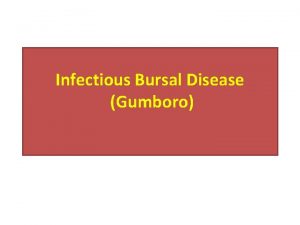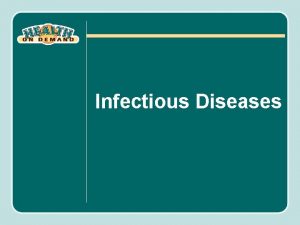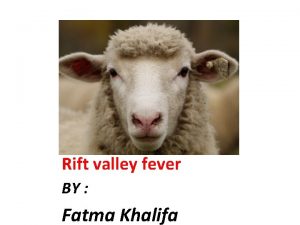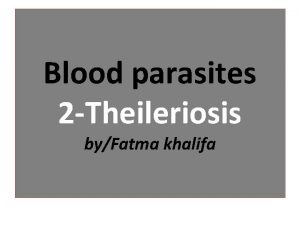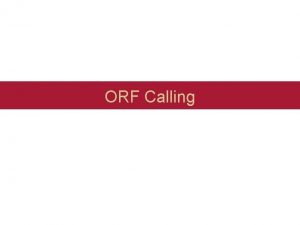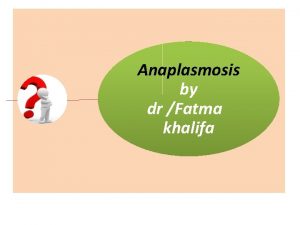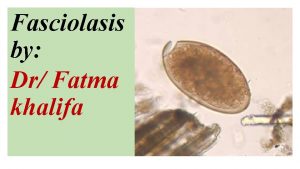Sore mouth infection Orf Dr Fatma Khalifa Defination


















- Slides: 18

Sore mouth infection Orf Dr: Fatma Khalifa

Defination Ø is an exanthemous disease caused by a parapox virus and occurring primarily in sheep and goats. Ø Orf virus is an epitheliotropic DNA PARAPOXVIRUS with a world distribution that induces acute pustular lesions in the skin of sheep , goats and man. Ø Orf virus is zoonotic.

Synonyms • • It is also known as : Contagious pustular dermatitis, Contagious ecthyma, Infectious labial dermatitis, Ecthyma contagiosum, Thistle disease and Scabby mouth.

Causative agent q. Family : poxviridae q. Genus : parapoxvirus q. Species : Orf virus

Host susceptiblity Øsheep and Ø goats. ØOther ruminants Ø that may on occasion develop sore mouth include musk oxen and gazelles.

Source of infection • Material from the lesions of an infected animal contains the virus. The virus can be transmitted to other animals through cuts or abrasions in the skin. • Orf virus is particularly hardy in scab material and can remain viable in the environment for months, possibly years. • Pastures, bedding, feed and feed troughs, and buildings may become contaminated with orf virus from released scab or lesion material.

Transmission • Orf is spread by fomites and direct contact. i. e : The teats of ewes or does may become infected through nursing lambs or kids. Any direct contact between animals — muzzle to muzzle or skin to skin — can result in transmission of the virus between animals. • In some environments, infection is injected by scratches from thistles of both growing and felled plants.

Orf virus orf virus • Animals infected with tyically develop scabby sores (lesions) around their lips, muzzle, and in their mouth. Humans that are infected typically develop ulcerative lesions or nodules on their hands. Infection with orf virus occurs throughout the world, wherever small ruminants exist.

Orf lesion • Symptoms include papules and pustules on the lips and muzzle, and less commonly in the mouth of young lambs and on the eyelids, feet, and teats of ewes. • The lesions progress to thick crusts which may bleed. • Orf in the mouths of lambs may prevent suckling and cause weight loss, and can infect the udder of the mother ewe, thus potentially leading to mastitis. • Sheep are prone to reinfection. • Occasionally the infection can be extensive and persistent if the animal does not produce an immune respons.

Epidemiological patterns • Incubation period is 4 -7 days. • Morbidity rate may reach up to 100%. • Mortality rate does not exceed 0. 5%. • Death occurs due to : Starvation of suckling lambs. • Recovered animals are immune for 2 -3 years.

Human infection • Infection with orf virus is usually confined to the epidermis of the skin. • Lesions (one to a few) or nodules will often occur on the fingers, hands, or the forearms. • Lesions begin as small papules that will become ulcerative in nature. • Orf virus lesions typically progress through six stages each lasting approximately one week.

Human infection • Other symptoms may include : • Mild fever, malaise (fatigue), or local swelling of lymph nodes. • Lesions generally range in size from 2 -3 cm but can be as large as 5 cm. • They can be painful but usually resolve on their own without scarring.

Lesions of Orf in human Infection in human with immunocomprised Orf infection on thumb

Diagnosis 1 - Epizootiological situation of the disease. 2 - Clinical signs and lesion. 3 -Laboratory diagnosis. 4 - Serological examination. 5 - Electron microscope examination of scab material. 6 - Histopathological examination of affected tissues reveals to cytoplasmic inclusion bodies.

Treatment • There is No approved treatment for an orf virus infection. However, the lesion can become infected with bacteria if not properly managed.

Vaccination • There are commercially available preparations of live virus marketed as vaccines. • Producers considering using an orf vaccine product in their flock should consult a veterinarian. • Vaccination practices vary depending on breed and geographic location, Because the orf vaccine is a live virus preparation, its use is only suggested for flocks that have previously experienced orf virus infection or in which vaccine has previously been used.

Vaccination • is made from scab material and usually given to ewes at the age of two months, but only to lambs when there is an outbreak.

Control 1 - Isolation of infected animals. 2 - Proper disinfection using 2% formalin. 3 - Vaccination at the beginning of the outbreak.
 Defination of infection
Defination of infection Defination of tuberculosis
Defination of tuberculosis Shadi khalifa
Shadi khalifa Orf transportation
Orf transportation Burj khalifa trigonometry
Burj khalifa trigonometry Urfp hku
Urfp hku Dpv08
Dpv08 Baki tuna yazıcı
Baki tuna yazıcı Kareem khalifa middlebury
Kareem khalifa middlebury Lisa orf
Lisa orf Burj khalifa crane operator
Burj khalifa crane operator Mimarimizdeki dini motifler
Mimarimizdeki dini motifler Burj khalifa comparison
Burj khalifa comparison Université de chlef
Université de chlef Rti graph
Rti graph Orf in bioinformatics
Orf in bioinformatics Khalifa humanitarian foundation
Khalifa humanitarian foundation Middlebury philosophy
Middlebury philosophy Khalifa dbs
Khalifa dbs
